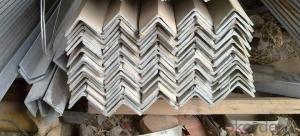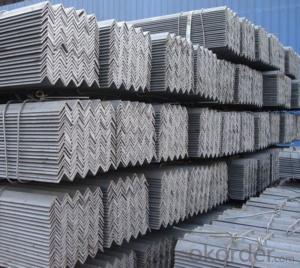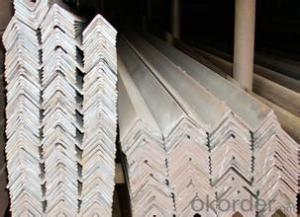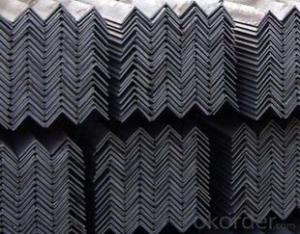Mild stainless steel angle for construction
- Loading Port:
- Tianjin
- Payment Terms:
- TT OR LC
- Min Order Qty:
- 10000 m.t.
- Supply Capability:
- 2000000 m.t./month
OKorder Service Pledge
OKorder Financial Service
You Might Also Like
Item specifice
Product Description:
OKorder is offering mild stainless steel angle for construction at great prices with worldwide shipping. Our supplier is a world-class manufacturer of steel, with our products utilized the world over. OKorder annually supplies products to European, North American and Asian markets. We provide quotations within 24 hours of receiving an inquiry and guarantee competitive prices.
Product Applications:
Mild stainless steel angle are ideal for structural applications and are widely used in the construction of buildings and bridges, and the manufacturing, petrochemical, and transportation industries.
Product Advantages:
OKorder's Steel angle are durable, strong, and resist corrosion.
Main Product Features:
· Premium quality
· Prompt delivery & seaworthy packing (30 days after receiving deposit)
· Corrosion resistance
· Can be recycled and reused
· Mill test certification
· Professional Service
· Competitive pricing
Product Specifications:
Detailed Informaion
Name | Equal/Unequal Angle Steel Bar |
Shape | Equal/Unequal Angle |
Standard | GB/ASTM/SAE/AISI/DIN/JIS/EN/BS |
Surface Treatment: | Black/Peeling/Polished/Machined |
Delivery Condition: | Hot Rolled or Forged/Peeled or Black Surface |
Test | SGS/UT 100% Elements Testing |
Certificate: | ISO/Mill Certificate |
Service: | 24 hours online service / |
more than 20 years trading and manufacture | |
Quality Assurance: | the third party inspection, such as SGS, BV, TUV…etc. is acceptable |
Packaging Details: | Seaworthy Packaging or as per customer's packing instruction |
Specification
hot rolled equal angle steel | hot rolled unequal steel angle |
specification(mm) | specification(mm) |
20*3/4 | 26*16*3/4 |
25*3/4 | 32*20*3/4 |
30*3/4 | 40*25*3/445*28*3/4 |
36*3/4/5 | 50*32*3/4 |
40*3/4/5 | 56*36*3/4/5 |
45*3/4/5/6 | 63*40*4/5/6/7 |
50*3/4/5/6 | 70*45*4/5/6/7 |
56*3/4/5/8 | 75*50*5/6/8/10 |
63*4/5/6/8/10 | 80*50*5/6/7/8 |
70*4/5/6/7/8 | 90*56*5/6/7/8/ |
75*5/6/7/8/10 | 100*63*6/7/8/10 |
80*5/6/7/8/10 | 100*80*6/7/8/10 |
90*6/7/8/10/12 | 110*70*6/7/8/10 |
100*6/7/8/10/12/14/16 | 125*80*7/8/10/12 |
110*7/8/10/12/14 | 140*90*8/10/12/14 |
125*8/10/12/14 | 160*100*10/12/14/16 |
140*10/12/14/16 | 180*110*10/12/14/16 |
160*10/12/14/16 | 200*125*12/14/16/18 |
180*12/14/16/18 |
|
200*14/16/18/20/24 |
|
Company Information
CNBM International Corporation is the most import and export platform of CNBM group(China National Building Material Group Corporation) ,which is a state-owned enterprise, ranked in 270th of Fortune Global 500 in 2015.
With its advantages, CNBM International are mainly concentrate on Cement, Glass, Iron and Steel, Ceramics industries and devotes herself for supplying high quality series of refractories as well as technical consultancies and logistics solution.
Packaging & Delivery
Packaging Detail | Sea worthy packing /as per customer's packing instruction |
Delivery Detail | 15 ~ 40 days after receiving the deposit |
Product Show
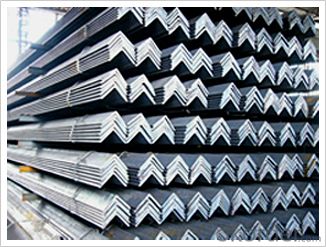
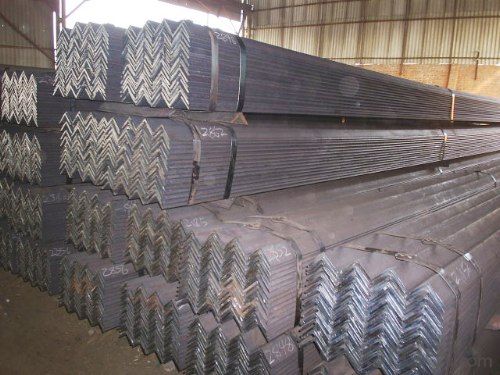

FAQ:
Q1: What makes stainless steel stainless?
A1: Stainless steel must contain at least 10.5 % chromium. It is this element that reacts with the oxygen in the air to form a complex chrome-oxide surface layer that is invisible but strong enough to prevent further oxygen from "staining" (rusting) the surface. Higher levels of chromium and the addition of other alloying elements such as nickel and molybdenum enhance this surface layer and improve the corrosion resistance of the stainless material.
Q2: Can stainless steel rust?
A2: Stainless does not "rust" as you think of regular steel rusting with a red oxide on the surface that flakes off. If you see red rust it is probably due to some iron particles that have contaminated the surface of the stainless steel and it is these iron particles that are rusting. Look at the source of the rusting and see if you can remove it from the surface.
- Q:Can steel angles be used for bracing?
- Yes, steel angles can be used for bracing. Steel angles are commonly used in construction and engineering projects to provide structural support and reinforcement. They are versatile and can be easily welded or bolted into place, making them suitable for various applications, including bracing. Steel angles are typically strong and rigid, which makes them effective in providing stability and resisting lateral forces. They are often used to brace columns, beams, and other structural elements, enhancing the overall strength and stability of the structure.
- Q:How do steel angles perform in extreme weather conditions?
- Steel angles are designed to be highly durable and resistant to extreme weather conditions. They are commonly used in construction and structural applications due to their strength and ability to withstand harsh environments. In extreme weather conditions such as hurricanes, heavy snowfall, or high winds, steel angles provide excellent protection against these elements. One of the key factors that contribute to the performance of steel angles in extreme weather conditions is their high tensile strength. Steel angles can withstand substantial loads and forces without deforming or breaking, making them ideal for withstanding extreme weather events. Additionally, steel angles are known for their excellent resistance to corrosion, which is crucial in areas with high humidity, saltwater, or acidic environments. Steel angles are also highly versatile, allowing them to be easily fabricated and customized to meet specific project requirements. This flexibility ensures that they can be used in a wide range of applications, including buildings, bridges, towers, and other structures that are exposed to extreme weather conditions. Moreover, steel angles can be coated or treated to further enhance their weather resistance. For example, a galvanized coating can provide added protection against rust and corrosion, extending the lifespan of the steel angles even in the harshest weather conditions. In summary, steel angles are designed to perform exceptionally well in extreme weather conditions. Their high tensile strength, corrosion resistance, and versatility make them a reliable choice for structures that need to withstand hurricanes, heavy snowfall, high winds, and other challenging weather events.
- Q:Can steel angles be used for signposts?
- Indeed, signposts can make use of steel angles. In a multitude of structural applications, including signposts, steel angles are frequently employed. Their strength, durability, and exceptional support for signs are worth mentioning. To construct a robust and dependable signpost, steel angles can be effortlessly welded or bolted together. Furthermore, steel angles display resistance to weather and endure harsh environmental conditions, rendering them fitting for outdoor usage. All in all, owing to their strength, durability, and adaptability, steel angles are widely preferred for signposts.
- Q:Are steel angles vulnerable to rusting?
- Yes, steel angles are vulnerable to rusting as they are made of steel, which is prone to corrosion when exposed to moisture and oxygen.
- Q:What are the different corrosion protection methods for steel angles?
- There are several different corrosion protection methods available for steel angles, depending on the specific application and environmental conditions. Some of the most common methods include: 1. Galvanization: This involves coating the steel angles with a layer of zinc, which provides excellent corrosion resistance. The zinc layer acts as a sacrificial anode, corroding instead of the underlying steel. 2. Paint coatings: Applying a high-quality paint coating to the steel angles can provide effective corrosion protection. The paint acts as a barrier, preventing moisture and corrosive substances from reaching the steel surface. 3. Powder coating: Similar to paint coatings, powder coating involves applying a dry powder to the steel angles and then baking it to create a durable and corrosion-resistant finish. 4. Epoxy coatings: Epoxy coatings are commonly used for steel angles that will be exposed to harsh environments or aggressive chemicals. These coatings provide excellent adhesion and resistance to corrosion. 5. Cathodic protection: This method involves using a sacrificial anode or impressed current to protect the steel angles from corrosion. The anode corrodes instead of the steel, providing long-term protection. 6. Barrier coatings: Barrier coatings, such as polyethylene or PVC wraps, provide a physical barrier between the steel angles and the surrounding environment, preventing moisture and corrosive substances from reaching the surface. 7. Hot-dip galvanizing: In this method, the steel angles are immersed in a bath of molten zinc, creating a thick layer of zinc coating that offers excellent corrosion protection. It is important to consider the specific requirements of the application when choosing a corrosion protection method for steel angles. Factors such as the environment, expected service life, and budget should be taken into account to ensure the most suitable protection method is selected.
- Q:Can steel angles be used for staircases?
- Yes, steel angles can be used for staircases. Steel angles are commonly used as structural supports in construction, including for staircases. They provide strength and stability to the staircase structure and can be designed to meet specific load-bearing requirements.
- Q:How do steel angles contribute to the overall stability of a structure?
- The overall stability of a structure is significantly influenced by steel angles, which serve multiple purposes. Primarily, steel angles are widely used as structural members in various applications, including building frames, bridges, and towers. Their L-shaped profile offers exceptional strength and load-bearing capabilities, making them ideal for supporting heavy loads and resisting bending or buckling. An important role of steel angles is to provide structural support and stability by distributing the load evenly across different components of the structure. By connecting elements like beams, columns, and girders, steel angles effectively transfer and resist weight and forces acting on the structure, thereby preventing potential collapse or failure. Furthermore, the overall rigidity and stiffness of a structure are enhanced by steel angles. When diagonal bracing elements made of steel angles are added, the structure becomes more resistant to lateral forces such as wind or earthquakes. These diagonal braces create a stable triangular configuration capable of withstanding horizontal loads. Consequently, the increased stability and resistance to lateral forces greatly contribute to the overall safety and durability of the structure. In addition, steel angles play a crucial role in mitigating torsional forces in a structure. Torsion occurs when one end of a structural member is twisted while the other end remains fixed, resulting in a twisting moment being applied to the structure. To counteract these torsional forces, steel angles can be strategically placed and connected, preventing excessive twisting or deformation that could jeopardize the structure's stability. To summarize, steel angles are vital components that contribute to the overall stability of a structure through various means. They offer structural support, efficiently distribute loads, enhance rigidity, resist lateral forces, and mitigate torsional forces. By incorporating steel angles into the design and construction of a structure, engineers can ensure its long-term stability, safety, and durability.
- Q:What is the maximum deflection allowed for a steel angle beam?
- The maximum deflection allowed for a steel angle beam typically depends on the specific design requirements, loading conditions, and industry standards. To determine the maximum deflection, engineers consider factors such as the beam's span, material properties, and the desired level of rigidity. Therefore, there is no standard maximum deflection for all steel angle beams, as it varies based on the specific application and design considerations.
- Q:How do you connect steel angles together?
- Steel angles can be connected together by various methods such as welding, bolting, or using steel angle brackets.
- Q:Can steel angles be used in solar panel installations?
- Yes, steel angles can be used in solar panel installations. Steel angles are commonly used as a structural support in various construction projects, including solar panel installations. They provide stability and strength to the solar panel system, ensuring that the panels are securely fixed to the ground or the mounting structure. Steel angles are durable and resistant to environmental factors, making them suitable for outdoor applications. Additionally, steel angles can be easily customized and fabricated to meet the specific requirements of the solar panel installation, allowing for flexibility and versatility in design.
1. Manufacturer Overview |
|
|---|---|
| Location | |
| Year Established | |
| Annual Output Value | |
| Main Markets | |
| Company Certifications | |
2. Manufacturer Certificates |
|
|---|---|
| a) Certification Name | |
| Range | |
| Reference | |
| Validity Period | |
3. Manufacturer Capability |
|
|---|---|
| a)Trade Capacity | |
| Nearest Port | |
| Export Percentage | |
| No.of Employees in Trade Department | |
| Language Spoken: | |
| b)Factory Information | |
| Factory Size: | |
| No. of Production Lines | |
| Contract Manufacturing | |
| Product Price Range | |
Send your message to us
Mild stainless steel angle for construction
- Loading Port:
- Tianjin
- Payment Terms:
- TT OR LC
- Min Order Qty:
- 10000 m.t.
- Supply Capability:
- 2000000 m.t./month
OKorder Service Pledge
OKorder Financial Service
Similar products
New products
Hot products
Related keywords
